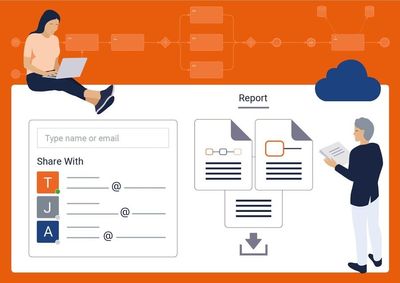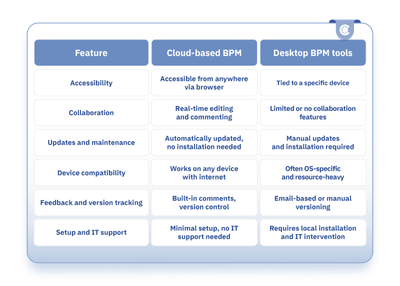Why cloud-based BPM is key to collaborative modeling
Written by Nela Lazarevic
17 November 2020 · 6 min read

Getting all the stakeholders on board in a timely and efficient manner has always been at the heart of successful business process modeling. Whether internal or external, business users or peer process modelers, collecting input from relevant players from different departments or even different organizations has been part of the routine.
With remote work skyrocketing, both employee and customer habits changed overnight. In this era of the so-called new normal, having formally defined processes through a widely used notation standard like BPMN has become important. To name a few, it minimizes execution inefficiencies due to individual interpretations of a task at stake, and it sets ground for process automation that can make or break a business.
The cumbersome, outdated nature of the desktop-tied BPM tools has become ever so evident, while cloud-based tools like Cardanit open the way to frictionless collaboration, allowing secure access from your Web-browser whether you’re modeling processes from your office desk or from your kitchen table.

Table 1. Comparison: cloud-based BPM vs desktop BPM tools
We had the opportunity to test the user-friendliness of Cardanit collaboration features in our own company, ESTECO. It also allowed us to assess the learning curve of our BPMN modeler, even for users with no prior experience. Here’s how we did it.
From informal practices to BPMN diagrams in a fast-growing company
At ESTECO, like in many organizations, the new normal accelerated the processes that were already at stake before the COVID outbreak. Our software house has seen a quick rise from a small, family-style business, to a company with over 100 employees and offices in three continents.
In a tiny business, information about procedures could stay informal and scattered among different people because informal communication was easy. But in a fast growing company with new employees coming in almost weekly, the need to formally document these processes and to create a unique source of truth for this information has gained paramount importance. This necessity grew exponentially when 80% of our workforce started working from home last March.
To sum it up, our Accounting and People Operations department needed to quickly adapt to the new circumstances and:
- Document internal processes in a way that is easy for everyone to understand.
- Collect all the process-related information in a single place, accessible by all employees, including those working remotely.
- Speed up the process of onboarding new employees.
Fast onboarding with Cardanit, even for first-time modelers
None of our colleagues at the Accounting and People Operations department had tried Cardanit before. Yet we’ve managed to familiarize them both with the tool and with the basics of the BPMN standard in just a couple of remote sessions with our internal BPMN expert.
As for the rest, they’ve managed to draw the BPMN diagrams for all their procedures on their own in just a couple of weeks, exchanging all feedback directly from the Cardanit modeler. There was no need to exchange emails and screenshots, or to attend endless Zoom or Meet conferences - Cardanit had everything they needed to collect and process feedback on the BPMN diagrams.

New hire procedure modeled in Cardanit
First, we set up a remote collaborative modeling session with our BPMN expert to introduce the basics of Cardanit and BPMN. Then our coworkers held a second session on their own to apply the acquired knowledge and design the first process diagram, without the BPMN expert. Finally, another session was held with the BPMN expert to check this model and transfer more knowledge about BPMN.
After a couple of procedures modeled this way, the Accounting and People Operations department started working on other process models independently, interacting with the BPMN expert only for feedback and to explore more advanced BPMN concepts. In just a few weeks, all the most important procedures were successfully modeled.

Company medical visit modeled in Cardanit
Thanks to Cardanit, they now have BPMN models as reference documentation for all their processes. This information is easy to understand even for the new hires. Learn how other companies use Cardanit in our customer success stories.

Interns onboarding modeled in Cardanit
The power of a cloud-based BPMN modeler
As we’ve seen in the example above, a user-friendly, cloud-based BPMN modeling tool is an efficiency booster for any organization that needs to quickly adapt to today’s challenges. The ability to quickly and painlessly train company staff to model their own business processes is priceless. But it’s also an invaluable tool for business analysts modeling processes for large organizations and for business consulting firms that juggle multiple BPM projects at any given moment.
Real-time collaboration from anywhere
The possibility to remotely access your workflows with no hardware limitations whatsoever, along with functionalities enabling real-time collaboration and sharing capabilities, or automatically generated process manuals are precious time savers for any business analyst, especially in these challenging times.
Cloud-based BPMN modeling, coupled with interoperability guaranteed by widely used standards like BPMN and DMN, are invaluable efficiency boosters no matter what BPM challenge you have at hand. It enables you to work faster and more accurately, and to share the results on the go in the form of highly readable diagrams that are intuitive even for non-experts.
From bottlenecks to streamlined feedback
Yet, old-style information sharing is still widely present more than many business analysts would like to admit. Print-outs, screenshots, feedback collected via email, excessive in person meetings or conference calls still create daily hurdles to efficient process modeling.
This scattered way of collecting and processing feedback can create bottlenecks that often manifest in the form of interpretation issues or unexpected last minute changes to process workflows. Needless to say, this approach to collaborative process modeling is a thing of the past.
Everyone on the same page, literally
On the other hand, fostering discussion on workflows and processing real-time feedback directly from a cloud-based modeler, accessible from anywhere, can significantly cut project completion times. You can literally get everyone on the same page directly from your BPMN tool: all the stakeholders, internal and external, people from different departments and even different organizations, from top management to process executors and fellow modelers.
Learning to model our processes in Cardanit has been easier than we thought. With no previous experience with BPMN, we got familiar both with the standard and with the tool in a matter of hours.
Centralized communication and automation-ready outputs
Handling all the conversations related to business process modeling from a unique, connected and accessible location can streamline project execution by minimizing the use of a multitude of communication tools available both within your organization and outside (Skype, Meet, Zoom, Drive…).
Key benefits include:
Thanks to versioning, you can keep track of all iterations and clearly communicate results without wasting endless hours on creating business process manuals.
XML-based interchange format allows for platform-independent exchange of BPMN 2.0 diagrams, avoiding vendor lock, guaranteeing seamless import-export of BPMN workflows, and setting the right foundation for process automation.
Available with all the above mentioned functionalities, Cardanit embodies the key principles behind the BPMN as declared by the MIWG group: transparency, inclusion, collaboration and openness.
And this is so regardless of the sector of application and complexity of the business process at hand.
Further reading
We’ve seen the benefits of collaborative modeling of complex processes including several organizations and covering different fields of expertise in a blog post about the use of Cardanit in the EU-funded COMPOSELECTOR project dedicated to composite materials design.
Furthermore, the testimonial from Process Modeling Specialist Michael Breda testifies to the benefits of Cardanit collaborative features in tackling a challenging merger process between two healthcare companies.
With a background in journalism, Nela Lazarevic worked as a Communications Specialist and Digital Marketing Specialist at ESTECO, the company behind Cardanit, from 2016 to 2022.
With a background in journalism, Nela Lazarevic worked as a Communications Specialist and Digital Marketing Specialist at ESTECO, the company behind Cardanit, from 2016 to 2022.
People also ask
Yes. Cardanit ensures secure access via browser and supports encryption and access control features that make it suitable even for sensitive or regulated processes.
Cloud-based BPM reduces the need for IT infrastructure, lowers maintenance costs, and speeds up modeling and feedback cycles—saving both time and money.
Yes. Cardanit allows multiple users to access and edit the same process model in real time. You can leave comments, track changes, and collaborate without version conflicts—ideal for cross-functional or distributed teams.
Yes. You can export BPMN 2.0-compliant diagrams in XML format or as PDFs, making it easy to share with clients, auditors, or stakeholders who aren’t using Cardanit.
Learn what key features and ingredients your BPMN editor should have to ensure a smooth and efficient business process mapping experience.
Key ingredients for efficient process mapping
Learn what key features and ingredients your BPMN editor should have to ensure a smooth and efficient business process mapping experience.
Key ingredients for efficient process mapping
Learn what key features and ingredients your BPMN editor should have to ensure a smooth and efficient business process mapping experience.
